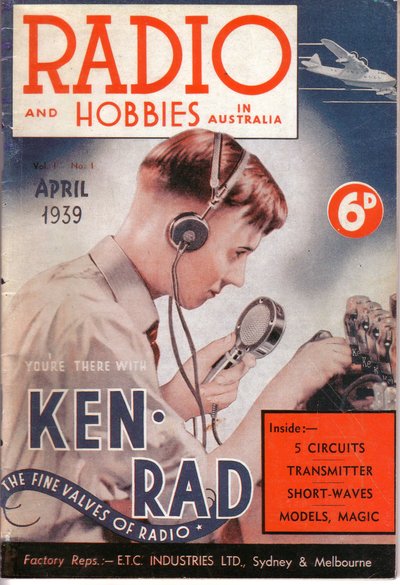
The first issue of Radio and Hobbies. This magazine was probably the most influential driver of the radio hobby in the valve era.
In Australia, like everywhere else, the start of the hobby came from radio in the 1920’s. It was radio based through the 1930’s and 1940’s, and then television appeared in the 1950’s. The term “electronics” took over in the 1960’s when transistors became available to the hobbyist, and were being used for many other circuits, besides those associated with radio.
For its small population, Australia had
a very large following of the hobby, and probably had more parts retailers
per head of population than anywhere else in the world. This may well come
from the DIY culture of Australians – our isolation forcing us to come
up with innovative ways of making do with what we had.
Electronics as a hobby in Australia has
always, up until the prevalence of the internet, been associated with the
magazines and parts retailers.
Australian Magazines.
Radio magazines containing constructional
articles were very popular and widely available. The take up of radio in
this country was rapid because of our isolation from the rest of the world,
and the large distance between communities.
In the 1920’s there was the “Wireless
Weekly” magazine which probably gave more encouragement to the hobby than
anything else. By 1939 “Wireless Weekly” had metamorphosed into “Radio
and Hobbies in Australia”. This new magazine dealt with the technical side
of radio only, and was a monthly publication. It also included some non-radio
related “hobby” articles which became less and less as time went on.
Radio and Hobbies in Australia.

The first issue of Radio and Hobbies. This magazine was probably
the most influential driver of the radio hobby in the valve era.
Radio and Hobbies was the bible for Australians
interested in radio. Its popularity soared and the constructional articles
were highly regarded. There were other magazines which came and went, such
as the “Australian Wireless Review” and while they were good publications,
they did not have volume of material presented in R&H.
Besides locally published magazines, those
from the U.S. and England were also available here; the U.S. "Radio News"
and England's "Wireless World" being typical.
During the 1950’s, Radio and Hobbies became
"Radio Television and Hobbies", as TV was now the “in thing”. Constructional
articles for TV sets issued forth, as did various technical articles on
the subject. As well as TV, home hi-fi was beginning to take off in this
era, with stereo and microgroove records being new technology. For the
next few years, articles were based largely around radio, television, hi-fi,
and the occasional test instrument.
Then, in the late 1950's, constructional
articles using transistors started to appear. Initially these were for
radio receivers, but then audio and test instrument based projects appeared,
as did all manner of gadgets, from power supplies to burglar alarms. The
transistor was responsible for this, because it allowed so many circuit
configurations that just did not suit valves at a practical level.
In 1965, "Radio Television and Hobbies"
renamed itself "Electronics Australia", in view of the fact that radio
and television was no longer the dominant force of the technology. This
was the era when the first integrated circuits became available, which
happened to spur on the next big thing; digital electronics.
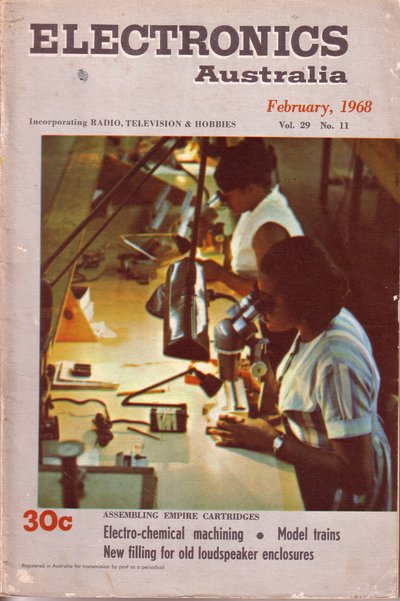
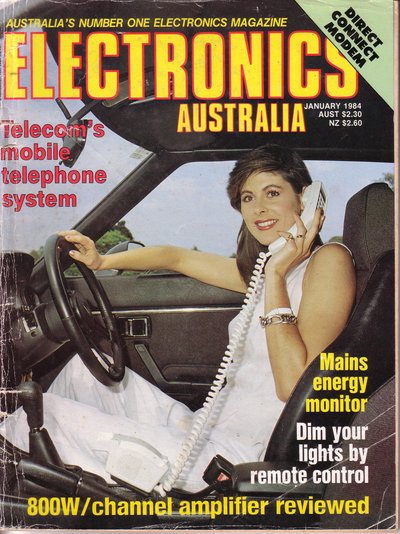
The changing face of Electronics Australia.
By the mid 1970's, radio projects were starting to drop off, and more and more digital projects appeared. From now on, most projects were digital, audio, gadget, or test instrument based. It was also the era of build your own amplifier and speakers.
Electronics Today International.
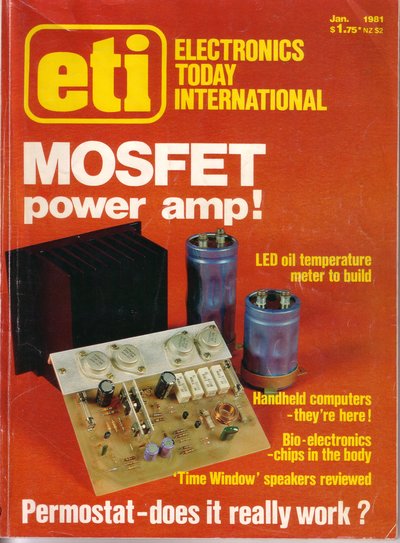
The first real competitor for the established monopoly of Electronics
Australia.
Another magazine appeared in 1971, "Electronics
Today International". It was seen as a fresh change, from the often seen
as conservative EA. It was very successful, and so we now had two competing
magazines. The initial concept was to set up ETI in other countries besides
Australia, which did happen, but eventually these overseas branches went
their own way, and were no longer associated with the Australian parent
company.
Like EA, ETI was largely project based,
and the parts retailers provided kits for most of the projects in both
magazines. "Hobby Electronics" was a short lived ETI spin-off from the
early 80's.
The 1980's magazine "Australian Electronics
Monthly" was good quality, but short lived. "Talking Electronics" was another
80's magazine, which was best known for its FM "bug" projects. It was a
small magazine produced by one person, Colin Mitchell, and was sporadic
in frequency of publishing. It still exists, but now only on the internet.
Silicon Chip.
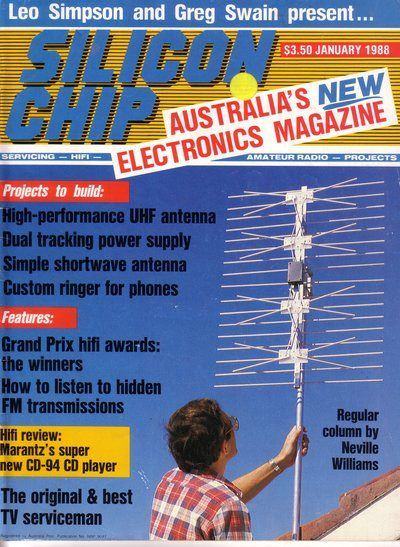
Most of the EA staff defected to create Silicon Chip after a change
of management.
The final magazine to appear was Silicon
Chip in 1987. This magazine came about because the original publisher of
EA had been taken over by another who wanted to change the direction of
the magazine (i.e. effectively dumbing it down). Most of the EA staff left
to set up Silicon Chip independently, and it became very successful. In
the meantime EA and ETI which now had the same publisher were combined
into one magazine.
By 2000, "Electronics Australia with Professional
Electronics and ETI" had rapidly gone downhill. It was then given the unfortunate
name of "EAT" (Electronics Australia Today). Just before its final death
in 2001, the last few issues were nothing like what the magazine once was.
Now totally devoid of projects, it was simply a review magazine of commercially
made consumer equipment.
Silicon Chip is the only surviving electronics
magazine in Australia, and one of few left in the world. Even the British
"Everyday Practical Electronics" now simply publishes projects from Silicon
Chip - no doubt assisting with the survival of SC. [Update August 2024:
SC has taken over EPE].
What has been unique about Australian electronics
magazines is the personal and informal nature in which they have been written,
but yet retaining a very high technical standard. Australians relate to
this, and to a lesser or greater degree, all the Australian magazines have
followed this format.
Contrast this with overseas magazines,
which nothing was known about the editor or the project contributors. Many
don't even provide their first names. Unlike in Australia, overseas magazines
had their project articles provided by random contributors. In Australia,
the articles were authored by the magazine staff. It was like a family
that one grew to know; each having their own individual style and particular
interest. Another thing that stands out with Australian magazines is amount
of detail given to constructing the project, and the reasons behind the
design.
The Electronics Stores.
Australia had always been well served
by radio parts retailers. Radio House, Radio Despatch Service, Levenson's
Radio, McGrath's, Waltham Dan, Ace Radio, just to name a few from the valve
era.
This suddenly changed around 1973 with
Dick Smith Electronics. Now, components were even more easy to get at cheaper
prices, since they were being directly imported. For those outside Sydney,
a very fast mail order service operated. As time went on, stores started
appearing in other cities and country towns and it eventually became Australia
wide, and then set up in NZ.
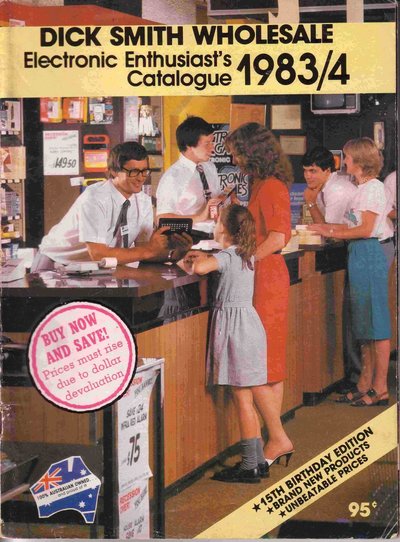
Dick Smith was the most significant change for electronics hobbyists
in Australia. Dick Smith, himself, is pictured on the front cover of this
catalog.
Tandy Electronics appeared on the scene in 1975. Based on the U.S. Radio Shack, they did things very differently to how it had always been done in Australia. Tandy stores popped up everywhere where electronics stores had never been seen before, such as in shopping centres. It was a franchise operation where just about anyone could set up shop. While their prolific outlets were convenient, they were generally more expensive than Dick Smith. They did not have any connection to the electronics magazines, and did not sell any kits, except a few of their own U.S. designs. As time went on, their range of components gradually dropped, and it became merely a consumer electronics store.
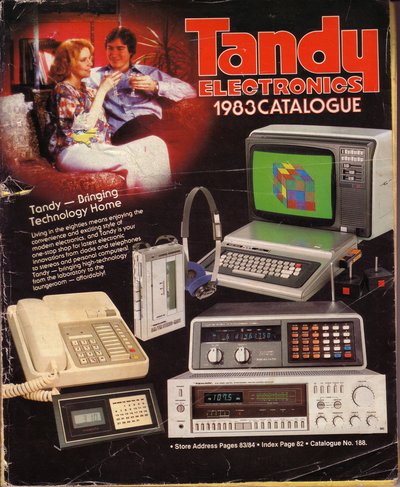
Tandy was expensive, but the products were good quality, and the
catalogs were free.
Both Tandy and Dick Smith rode upon the
CB boom of the late 1970's to their considerable advantage. In fact, Dick
Smith himself, was a leading force in getting CB legalised in Australia.
There were a few small retailers who were
obviously operating on the Dick Smith model; Bill Edge, Altronics, John
Carr ( which became Jaycar), Rod Irving, and Geoff Wood come to mind.
Dick Smith got out of electronic components altogether around 2008, and was then only a consumer electronics retailer. Dick Smith, himself, had sold the business to Woolworths in 1982. Tandy ceased to exist in Australia in the early 90's and was absorbed by Dick Smith. For a short time there was this strange situation of Tandy branded items in DSE stores.
Since the mid 2000's there have been only two major retailers for hobbyists; Jaycar and Altronics. Both seem to be doing quite well given that the number of stores is increasing.
The New Era.
So what happened? Until the early 2000's
electronics was a popular hobby, although there had been a drift more towards
computers and microprocessor based projects
Radio projects were now extremely rare.
Amateur radio is now almost dead, since the internet has taken over the
same function, and domestic radios have been uneconomic to build since
the 1960's. Therefore, magazines think it's not worthwhile publishing such
projects. In fact I would say that radio is just seen as "old fashioned",
as is any kind of "analog" circuitry.
As I write this in March 2018, the changes
are becoming more rapid, and as a mainstream hobby, electronics
is now dead. It is a niche interest. Looking at this month's Silicon Chip,
the magazine is very different to what it was when it started in 1987.
Plugging together Arduino and other microprocessor modules, seems to be
where the hobby is in the present day. Problem is, where does one learn
about ohm's law, or semiconductor biassing for example?
Most projects in SC now contain a microprocessor
with some kind of readout. If it's not an LCD or LED display, the said
microprocessor drives a power semiconductor for some kind of power control.
The problem here is simple. I can build
just about any project out of a magazine going back to the late 1920's,
if I want to. Introduce a microprocessor or obscure IC, and one can forget
about building it in the future. It's a case of build it now, and hope
nothing goes wrong with the micro in the future. Yet, a PCB full of BC548's
and 4000 series IC's will always be serviceable, and is not reliant on
a code, and a means to program it, which may be very difficult in the future.
There is a lifetime supply of valves out there, so valve projects are quite
viable for the foreseeable future. Transformers for valves, and associated
parts like tagstrips and valve sockets are being made again..
Unfortunately, SC's circulation is falling,
and most other electronics magazines have disappeared altogether. Many
newsagents don't even stock what magazine titles are left - and newsagents
themselves are almost gone! That's not to say the quality of SC has dropped,
which it hasn't, but is merely a reflection of society in the present day.
People would rather spend time on a computer clicking a mouse, or tapping
on a smartphone screen, interacting with virtual "friends", than actually
building something as simple as a crystal radio.
Radio projects have been uneconomic since
the 1960's, unless it's for something specialised, or is being presented
as a "learning" type of project. The modern generation tends to listen
less to the radio anyway, due to internet availability. The rash of inverter
and power supply projects, through the 1980's and 1990's, ceased long ago,
once these devices became very cheap already made.
On a positive note, there has been a revival
of valve electronics since the 1990's. This was until recently, vehemently
resisted by SC, but realising that it's the Vintage Radio column that is
responsible for many readers continuing to buy the magazine, they have
relented, and have subscribed to reader's wishes for projects, such as
valve amplifiers.
Younger enthusiasts have suddenly discovered
valve electronics, and there is a now whole new niche interest. Unfortunately,
a lot of this interest has been spurred on by various internet sites of
questionable technical quality, a few forums full of personal insults,
and more misinformation. Still, for a generation that no longer reads printed
magazines and books, they have to learn somewhere, and learn the hard way
if necessary...
Surface mount components are becoming common
for "modern projects" simply because that's what the manufacturers are
providing, and magazines want to be seen as keeping up with the times.
The video modulator project in SC from March 2018 is a good example. It
could have been designed with all conventional components - which incidentally
I already have, but the designer decided to use SMD where possible. I would
have to order virtually all the parts to make this project, despite already
having most of the components in their standard, non SMD form.
I notice a reduction in the amount of
available kits for sale too. Once the pages of the Jaycar catalog would
be full of magazine kits. In fact, you could assume that each project,
presented each month, would appear as a kit and be in the catalog for several
years. Now this is the exception. The new 2018 Jaycar catalog shows just
16 kits from EA/ETI/SC, and this going back to the 1980's. The rest of
their kits are in-house or third party. Virtually none of the other "kits"
are component level, but are instead pluggable modules.
Update 2020: A rather depressing
note in the 2020 Jaycar catalog states that once common leaded components
are now becoming difficult to get from the manufacturers.
Where is it all headed? My guess is the
niche interest in valve electronics will continue to be popular, helped
along by things "retro" being in vogue. Solid state projects that don't
use a microprocessor will become less and less common. I don't expect printed
magazines to be around much longer, especially once the baby boomer generation
dies off. Certainly, Silicon Chip has been on the internet for some time
- they have had to have that presence to keep readers. The amount of young
people that read printed material is too small to keep them viable otherwise.
In the future just about all information will come from the internet.
The interest in real, component level,
electronics will still be there, but just shared amongst a few.
Update 2021: With my recent
work on the Solid State Fremodyne, and a letter in the September 2021 Silicon
Chip, I have been reminded of another change. Radio receiver projects,
unless they pick up AM or FM broadcasts are now dead. This is one of the
reasons I have never presented any short wave receiver projects on this
site. The age of short wave broadcasts is over, having been replaced by
the internet. What little remains is certainly not of interest. Similarly,
outside the FM broadcast band, it is completely pointless designing and
presenting any other kind of VHF receiver project, since most of what remains
is now digital. The same remarks apply to UHF receivers. It is for this
reason that my once well used scanners lie dormant, having been packed
away in a cupboard for several years. It is well to keep in mind that even
the days of MW AM and VHF FM broadcasts are numbered, since it is the policy
of the ITU to eliminate all analog transmissions.
With the recent unfortunate death of Jaycar's
owner, my guess is that this company will be headed down the same path
as Dick Smith. Australia will join the rest of the world, only buying components
from the internet.